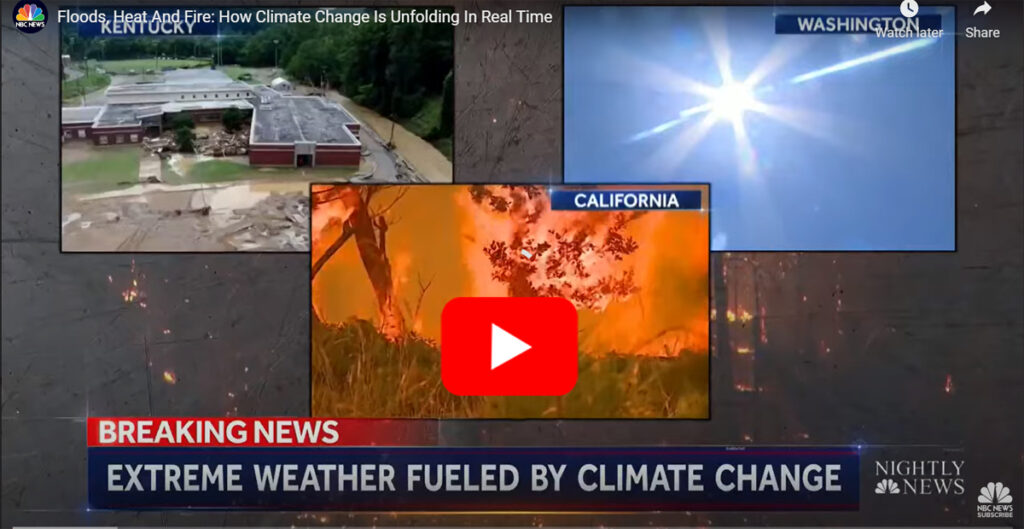Dear Friends,
“It was the best of times, it was the worst of times,” to borrow from one of literature’s most famous lines. In the climate world, July brought evidence of both.
It was the “best of times” because Congress finally stepped forward with a truly historic, surprise deal to enact what’s been called the most ambitious climate action ever undertaken by the United States. Simply put, the bill could enable us to cut greenhouse gases and put us within range of the ambitious targets needed to slow planetary warming. (Details below.)
It was the “worst of times” because of the numbingly frequent cascade of climate-enhanced, record-breaking weather disasters we experienced last month, and the realization that this type of destruction will only get worse unless we act.
In the American South, Northeast, and Pacific Northwest, temperatures broke heat records so many times we’d sound like a broken record to recount them. Britain faced down a 104℉ heat wave – the highest temperatures that nation has ever recorded – and which scientists say was made 10 times more likely due to climate change. Thousands died from heatwaves in Spain and Portugal.
Torrential rains and flooding – created in part because excess greenhouse gases have overheated our atmosphere and warmer air can hold more water vapor – wreaked havoc across the globe as well, including back-to-back inundations of St. Louis and eastern Kentucky.
Human misery is incalculable, but economic losses aren’t. The National Centers for Environmental Information puts the 2021 costs for 20 different billion-dollar U.S. disasters at $152B. It is only August, but we are on track to repeat that record. Not all natural disasters are impacted by climate change, but scientists say climate change is stacking the deck – making many of these events more likely to happen and more severe when they do.
So indeed, the best of times and the worst of times. And as we ponder our next steps we might remember the continuation of Dickens’ famous sentence, “… it was the age of wisdom, it was the age of foolishness …”
There are ample quantities of both right now as we try to address the climate crisis. Let’s hope that wisdom prevails.
Sincerely,
The C-Change Conversations Team
Notable Quote
“It’s not a Democrat bill, it’s not a Republican bill, it’s definitely not a ‘green’ bill, it’s a red, white and blue bill.” U.S. Senator Joe Manchin III (D-WV) regarding the “Inflation Reduction Act of 2022”
News of Hope
The most hopeful news last month and being debated this week: Senate Democrats’ new climate bill, robust and impressively broad-reaching with provisions to ramp up wind, solar, and geothermal energy production while offering tax incentives to businesses and to consumers for electric vehicles and investments in home energy efficiency.
But the bill may be most remarkable for the concessions it includes for fossil fuel producers. Driven by Senator Joe Manchin of West Virginia – the Democrats’ holdout vote on climate legislation until now – these concessions recognize that a managed transition to carbon neutrality requires some continued use of fossil fuels for the immediate future. Some climate activists criticize that approach, but consensus is building that this bill could be a game-changer.
Given the litany of climate disasters in recent years, we’re not entirely surprised to see that Washington’s polarization around climate action is no longer a given at the state and local levels. We are encouraged to see climate initiatives – increasingly crossing partisan lines – in states like Colorado and Ohio. They provide important avenues for many critical steps that can’t or may not happen nationally.
We’re equally excited by the accelerating drumbeat of progress coming out of the private sector for battery technologies and electric vehicles – making them absolutely ready for their primetime moment under the new bill. If you’re in the market for a new car, you’ll be happy to hear that some new electric models pay for themselves within a year. A prototype of one luxury brand has achieved an extraordinary range of 747 miles on a single charge.
Outside of the transportation sector, batteries are playing a starring role as well. New ‘megapak’ batteries, the size of shipping containers, are enabling renewable energy to handle more of our energy needs, even at the end of the day when demand spikes but the sun is no longer shining and the wind hasn’t started to blow. California is using batteries to phase out gas plants and in Hawaii batteries will soon replace the last coal plant.
In fact, in most places worldwide, it is cheaper to replace an existing coal plant with renewable energy coupled with batteries than to replace it with a new natural gas plant. In this country, it is projected that renewable energy, coupled with batteries and higher efficiency programs, will be significantly cheaper than electricity from existing natural gas plants by 2035. Though we clearly need natural gas as we manage a smooth transition toward a clean energy economy, gas’s role as a baseload electricity provider is not as secure as it seemed just two years ago.
To take full advantage of these new, cheaper energy sources, we need to update our antiquated and balkanized electricity grid. A modernized grid is also of paramount importance to prevent hackers and sabotage, as well as to harden against natural disasters. New electricity transmission lines, sorely needed around the country, have been notoriously difficult to build due to complex planning and permitting processes. That’s why we’re heartened that MISO – which operates the grid serving states from Minnesota to Louisiana – just announced that 18 new high-power transmission lines are being added in order to bring online 53 gigawatts of energy from renewable sources and to phase out coal plants. The package is being hailed as an important national model.
‘Nature-based’ solutions are gaining ground, too. Large-scale natural measures such as reforestation could provide up to a third of the emissions reductions required by 2030 to meet the Paris Agreement targets. So it’s great to hear the U.S. has a new plan to plant one billion trees and that 36 countries now have more trees than they did in 2000. Given the global plague of wildfires in recent decades and the active forest-clearing policies in some nations, this net gain is heartening.
And lastly, we report with pleasure (and a wait-and-see attitude) on climate initiatives from a rather surprising place – the Persian Gulf. Following Saudi Arabia’s pledge to become net-zero by 2060, the world’s biggest oil company, Saudi Aramco, just published its first sustainability report. It outlines how the company plans to reach net-zero emissions by 2050 through increased investment in renewables and through the carbon offset market. While this is an important development, we must note that the company’s pledge was limited to reducing emissions from energy they buy to run their operations and the emissions from the creation of their products, not “Scope 3” emissions, which are produced by their supply chain and customers’ use of their products.
And The Wall Street Journal reports that the United Arab Emirates is emerging as a global leader in renewable investments, [paywall] especially in the developing world. If leaders like these from the epicenter of oil and gas recognize the need to pivot toward clean energy, it is hopeful news indeed.
News of Concern
The Supreme Court issued a historically consequential climate change decision that limits the Environmental Protection Agency’s ability to issue broad regulations on greenhouse gas emissions from power plants. Climate planners fear the decision could have far-reaching consequences because in the absence of national legislation, regulatory agencies like the EPA have been at the forefront of federal climate action.
While we emphasized July’s so-called ‘heat apocalypse’ in the introduction above, a few stark headlines crystallized the heat problem for us this month with unusual clarity:
Greenland Is Melting. The ice sheet, which holds enough frozen water to raise sea levels by some 24 feet, was recorded melting this month at the rate of six billion tons per day. That’s enough to cover the entire state of West Virginia in a foot of water. Every day.
The Great Salt Lake Is Drying Out. The water level in July fell to the lowest point ever recorded, pushing the region to the verge of ecosystem collapse, according to scientists.
Texas Ranchers are in ‘Panic Mode.’ With heat-driven shortages of hay and water, their animals can’t be sustained affordably. The answer has been a month of firesale auctions and long-term questions.
Italian food lovers here at C-Change Conversations were particularly struck that like the Texas cattle ranchers, Italian parmesan cheese producers fear for their future. Drought along the Po river valley is creating an ‘extreme crisis’ for dairy herds and their products.
Through it all, economic, weather, and war-related realities keep pushing up fossil fuel use. Heat waves in China led to record electrical use, straining the nation’s grid, and prompting China’s premier to advocate for more coal production. In response to turmoil in global energy markets, Shell Oil is investing billions in its Gulf of Mexico facilities and locking in drilling plans for years to come.
Meanwhile, Europe’s loss of Russian natural gas in the shadow of the Ukrainian invasion has led Britain and several EU nations to announce plans to restart phased out coal plants this winter and build new natural gas infrastructure. One highly regarded research firm estimates the results will be a 5% increase in greenhouse gas emissions this year and next.
Although that is troubling, we see cause for optimism in the European commitment to keep their emissions pledges by making steeper cuts in years to come. Policy makers pushed through a raft of measures to meet those goals in the last month, including a ban on new internal combustion vehicles starting in 2035.
And so we end our catalogue of concerns on a positive, hopeful note: we may be at a turning point in Washington. That may create a tipping point globally. If the U.S. climate bill becomes law and the Europeans fulfill their existing commitments, we can get on track to stay at safer emissions levels. We’re not there yet, but it’s a pretty nice thought as we head into August.
Notable Video
No time to read? This NBC news clip explains how extreme weather (like much of the record-breaking type of events we experienced in July) is fueled by climate change.



